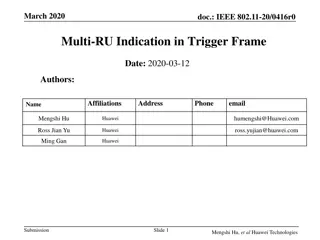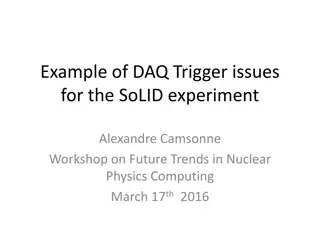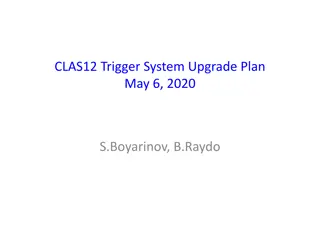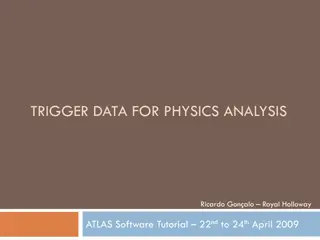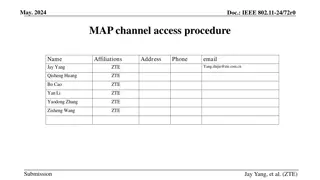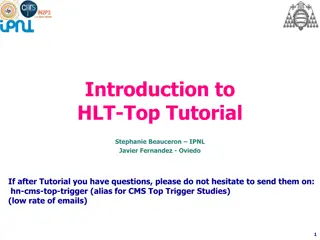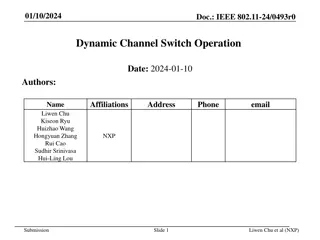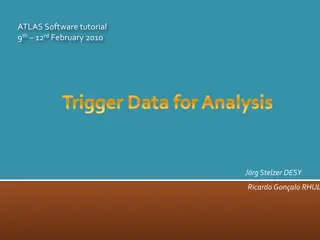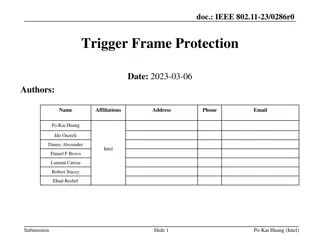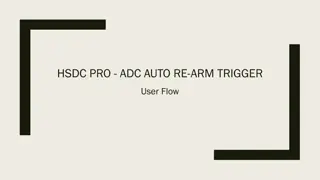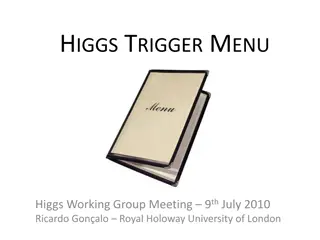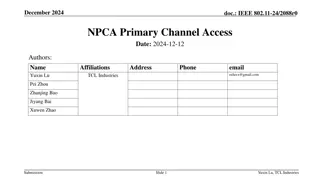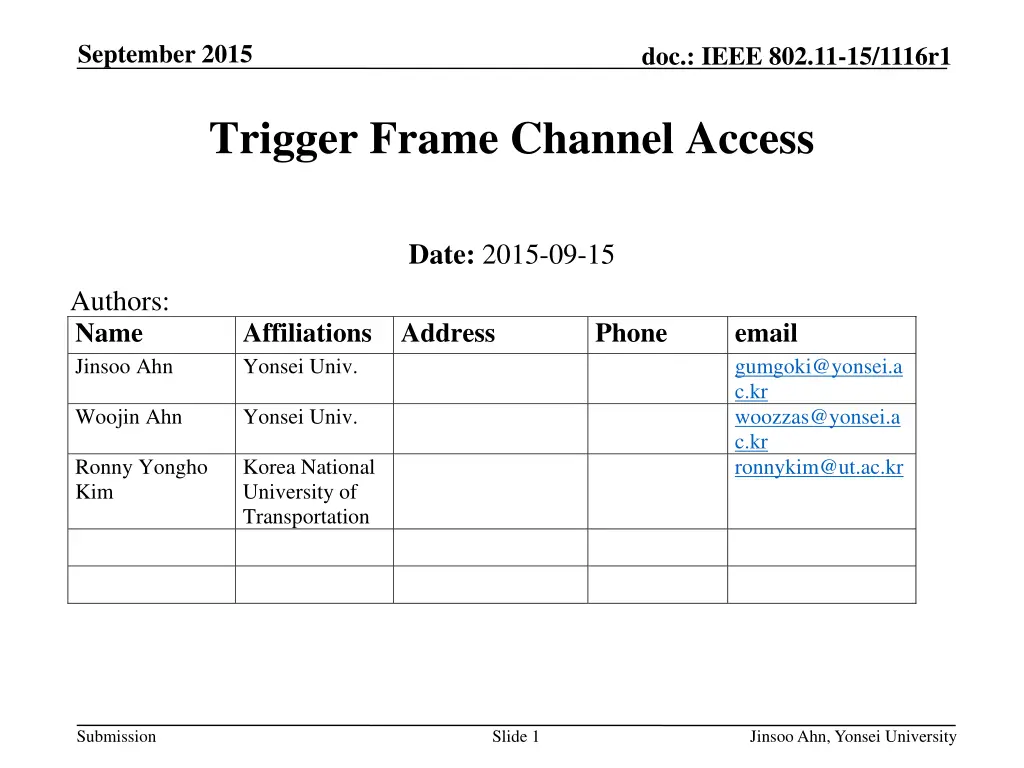
IEEE 802.11-15/1116r1 Trigger Frame Channel Access Overview
Explore the details of trigger frame channel access in the IEEE 802.11-15/1116r1 document. Learn about trigger frames, UL TXOP initiators, data transmission considerations, and channel access methods. Understand concepts like SU transmission, RTS/CTS transmission, DL MU-MIMO transmission, and trigger frame-based channel access. Dive into EDCA parameters, AP configurations, STA roles, and more in this informative review.
Download Presentation

Please find below an Image/Link to download the presentation.
The content on the website is provided AS IS for your information and personal use only. It may not be sold, licensed, or shared on other websites without obtaining consent from the author. If you encounter any issues during the download, it is possible that the publisher has removed the file from their server.
You are allowed to download the files provided on this website for personal or commercial use, subject to the condition that they are used lawfully. All files are the property of their respective owners.
The content on the website is provided AS IS for your information and personal use only. It may not be sold, licensed, or shared on other websites without obtaining consent from the author.
E N D
Presentation Transcript
September 2015 doc.: IEEE 802.11-15/1116r1 Trigger Frame Channel Access Date: 2015-09-15 Authors: Name Jinsoo Ahn Affiliations Address Yonsei Univ. Phone email gumgoki@yonsei.a c.kr woozzas@yonsei.a c.kr ronnykim@ut.ac.kr Woojin Ahn Yonsei Univ. Ronny Yongho Kim Korea National University of Transportation Submission Slide 1 JinsooAhn, Yonsei University
September 2015 doc.: IEEE 802.11-15/1116r1 Introduction Trigger Frame is UL TXOP initiator and it is transmitted by AP STA[1] This is the case of transmitting TXOP initiator without its data transmission Transmitting TXOP initiator to receive data TXOP holder STA Data Tx STA Other TXOP initiators like RTS Frame are transmitted by its Data Tx STA Need to consider channel access method of Trigger Frame due to these different property Submission Slide 2 JinsooAhn, Yonsei University
September 2015 doc.: IEEE 802.11-15/1116r1 Review SU simple transmission TXOP Initiator = Tx Data AP DL PPDU AIFS BA STA EDCA parameters follow AC of Tx Data Channel Access with EDCA Parameters for data transmission In this case, TXOP Initiator is Tx Data EDCA parameters of Data frame follows Access Category of Data frame Submission Slide 3 JinsooAhn, Yonsei University
September 2015 doc.: IEEE 802.11-15/1116r1 Review SU RTS/CTS transmission TXOP Initiator Tx Data AP DL PPDU RTS AIFS CTS BA STA EDCA parameters of TXOP Initiator follow AC of Tx Data Data frame does not use EDCA, RTS does. TXOP Initiator Tx Data TXOP holder = Data Tx STA EDCA parameters of RTS follows Access Category of Data frame Submission Slide 4 JinsooAhn, Yonsei University
September 2015 doc.: IEEE 802.11-15/1116r1 Review DL MU-MIMO transmission[2] AC_VO AC_VI AC_BE AC_BK AP STA 1 DL PPDU BAR BAR AIFS STA 2 DL PPDU STA 3 DL PPDU Backoff AIFS[BE] CW[BE] Backoff AIFS[BK] CW[BK] BA1 BA2 BA3 Backoff AIFS[VO] CW[VO] Backoff AIFS[VI] CW[VI] STAs Virtual Contention [Choose Primary AC] EDCA parameters follow Primary AC TXOP Initiator = Tx Data Multiple AC could exist on DL Data Choose Primary AC by virtual contention DL OFDMA could reuse this scheme Submission Slide 5 JinsooAhn, Yonsei University
September 2015 doc.: IEEE 802.11-15/1116r1 Trigger Frame Based Channel Access AP AIFS Trigger Frame M-BA STA 1 UL PPDU STA 2 UL PPDU STA 3 UL PPDU STAs Which EDCA parameters trigger Frame need to follow ? MU UL begins with Trigger Frame transmitted by AP TXOP Initiator Tx Data TXOP holder Data Tx STA Multiple AC could exist on UL Data and it might be difficult to know Submission Slide 6 JinsooAhn, Yonsei University
September 2015 doc.: IEEE 802.11-15/1116r1 Trigger Frame Based Channel Access Sol 1 AC feedback before Trigger Frame Transmission Access Category of UL Data need to be reported perfectly Using virtual contention method like MU DL case Pros EDCA Parameters of UL Data could be applied for Trigger Frame Channel Access Cons Perfect feedback need to be preceded 1-bit UL Data presence feedback is not sufficient Random Access Trigger Frame(TF-R) cannot justify its EDCA parameter Submission Slide 7 JinsooAhn, Yonsei University
September 2015 doc.: IEEE 802.11-15/1116r1 Trigger Frame Based Channel Access Sol 2 New Access Category for Trigger Frame Setting New EDCA parameters for Trigger Frame of MU-UL Regardless of UL Data contents, Trigger Frame Access Category would be applied for Trigger Frame Channel Access Not only constant EDCA parameters, but also variable EDCA parameters could be considered Related to channel bandwidth, number of users, etc. Pros Simply implemented, AC feedback procedure is not needed Cons Cannot reflect access category of UL Data Submission Slide 8 JinsooAhn, Yonsei University
September 2015 Further Discussion on Trigger Frame Channel Access doc.: IEEE 802.11-15/1116r1 Trigger Frame Failure Trigger Frame failure could be justified by following UL PPDU(s) An UL OFDMA MPDU/A-MPDU is the acknowledgement of the trigger frame. When the AP receives MPDU correctly from at least one STA indicated by trigger frame, the frame exchange initiated by the trigger frame is successful.[1] If Trigger Frame failed to access channel, its exponential back-off procedure need to be considered again If trigger frame need to be retransmitted, exponential back-off would be adopted until maximum retransmission count in conventional 802.11 There are no need to retransmit Trigger Frame due to its validity of scheduling Making new Trigger Frame is more effective Submission Slide 9 JinsooAhn, Yonsei University
September 2015 Further Discussion on Trigger Frame Channel Access doc.: IEEE 802.11-15/1116r1 AP will contend with other stations with initial CW AP New Trigger Frame or DL Frame, etc. Trigger Frame No Response No Response No Response STAs Trigger Frame Failure would delete Trigger Frame in Buffer Trigger Frame Failure If trigger frame is not retransmission frame or its retransmission count is fixed to 0, every trigger Frame might access channel with initial size of contention window[3] Submission Slide 10 JinsooAhn, Yonsei University
September 2015 Further Discussion on Trigger Frame Channel Access AP will contend with other stations with doubled CW AP doc.: IEEE 802.11-15/1116r1 BA 2 New Trigger Frame or DL Frame, etc. Trigger Frame No Response No Response No STA2 UL PPDU Response STAs Trigger Frame Failure would delete Trigger Frame in Buffer Trigger Frame Failure No CW doubling may cause congestion and fairness problem To solve these problems, doubled CW could be applied after trigger frame failure Submission Slide 11 JinsooAhn, Yonsei University
September 2015 doc.: IEEE 802.11-15/1116r1 Conclusion DL-OFDMA could reuse virtual contention channel access AC Feedback is not easy way to using Trigger Frame Channel Access Need feedback overhead and it limits use of MU UL transmission Justifying Access Category for Trigger Frame is more simple and effective way Trigger Frame does not need to be retransmitted Scheduling validity may not be guaranteed due to large delay Instead of retransmission, trigger frame with same scheduling information could be transmitted after failure of trigger Frame Congestion and Fairness Problems could be solved by doubling CW after trigger frame failure Submission Slide 12 JinsooAhn, Yonsei University
September 2015 doc.: IEEE 802.11-15/1116r1 StrawPoll 1 Do you agree to add to the TG Specification Frame work document? 4.1. DL-OFDMA shall reuse sharing an EDCA TXOP mechanism of DL MU-MIMO. Y N A Submission Slide 13 JinsooAhn, Yonsei University
September 2015 doc.: IEEE 802.11-15/1116r1 StrawPoll 2 Do you agree to add to the TG Specification Frame work document? 4.1. Spec shall define new EDCA parameter values(TBD) of trigger frame. Y N A Submission Slide 14 JinsooAhn, Yonsei University
September 2015 doc.: IEEE 802.11-15/1116r1 StrawPoll 3 Do you agree to add to the TG Specification Frame work document? 4.1. Spec shall define a trigger frame as a control frame without retransmission. Y N A Submission Slide 15 JinsooAhn, Yonsei University
September 2015 doc.: IEEE 802.11-15/1116r1 StrawPoll 4 Do you agree with that in case of trigger frame failure, next frame transmission shall use doubled CW? Y N A Submission Slide 16 JinsooAhn, Yonsei University
September 2015 doc.: IEEE 802.11-15/1116r1 References [1] 15/0132r7 Spec Framework [2] 10/1123r0 TXOP Sharing for DL MU-MIMO Support [3] 15/0878r0 Issues on Trigger Frame Retransmission Submission Slide 17 JinsooAhn, Yonsei University



